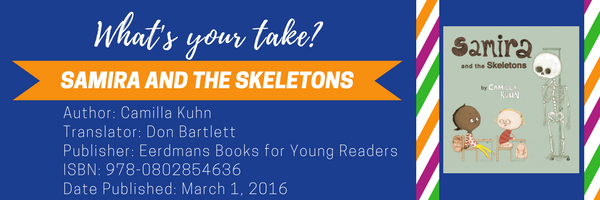Compiled by Janelle Mathis
This installment of April’s My Take/Your Take focuses on responses to a title that is on the USBBY 2017 “Outstanding International Book” List. Bill Visco, a doctoral student and high school English teacher, and April Walker, a doctoral student and elementary teacher with a focus in Language Arts and Social Studies, share their responses to Samira and the Skeletons (2016) written by Camilla Kuhn and published by Eerdmans Books for Young Readers. This book was translated from Norwegian by Don Bartlett and humorously shares the story of a child who is obsessed with seeing everyone as walking skeletons after a lesson in school about skeletons.

BILL: Samira and the Skeletons by Camilla Kuhn is a unique and interesting tale about the imagination of a young girl while at school. Kuhn does an excellent job of revealing how a child’s imagination can sometimes get the best of them. When Samira starts seeing imaginary skeletons framing everyone around her after learning about the skeletal system in school, it made me laugh because I can imagine thinking things like that when I was younger.
Now, while I do like the premise, it goes a little to the extreme. The fact Samira stops playing with her best friend Frida just because she sees her skeleton might be confusing to some younger readers. It was to me. I did enjoy the way Kuhn used Samira’s mother as the catalyst to break her out of her skeleton-fearing ways. Samira’s mom discussing cutting the skeleton out of her daughter so she wouldn’t have it anymore reminded me of my mom who used to ask me if I wanted something cut off if I complained that it hurt.
In the end, this is a clever story and I enjoy the carryover to the next day’s lesson where they are learning about the muscles in the human body. Of course, Samira now sees everyone’s muscles. The illustrations are quirky and while I could see that some might like it, I find it slightly “off putting,” although, I will say that the illustrations do seem to match what I would assume is the view of a child.
APRIL: Samira and the Skeletons is a text that would appeal to many young readers with an active imagination. Any teacher or parent who has known a child who fixated on something and didn’t want to let it go could relate to Samira fixating on the idea that skeletons are everywhere, and she doesn’t want one.
I could see this being a clever text to use when introducing skeletons and muscles in an early elementary classroom. The illustrations are whimsical. They don’t bother me, but as Bill mentioned, they could be “off putting” for some. I also could see some young children finding the illustrations a little scary. The illustrations remind me of Tim Burton’s style of animation.
I love the way the mom in the story handles the situation; this is how my mom would have reacted (with sarcasm and a sense of humor). However, some kids may be disturbed that the mom is willing to cut out her daughter’s skeleton. It would probably depend on the age of the reader and how literal a thinker they still are. Children old enough to pick up on sarcasm would really enjoy the story. Reflecting on when I was teaching fifth grade, I absolutely could see having a lot of great class conversations using Samira and the Skeletons.
BILL: Now that you mention it, I see the Tim Burton type of illustrations to this story. I agree with you that the book could be used to introduce a skeleton unit or muscle unit and it would be something fun for the kids. I also agree that this is a great view of kids who get fixated on things. I am not sure that the mom cutting the skeleton would worry the kids because I think that many of them would see this as a joke, but you never know.
I still think the most confusing part would be that Samira kind of abandons her friend just because she can see her skeleton. She won’t sit with her at lunch or say goodbye to her when they leave school, all because she can see the skeleton. Perhaps there is a deeper meaning about seeing skeletons (or seeing the true person) and then realizing that we all have “skeletons,” but I am not sure if the book is meant to go that deep.
APRIL: I didn’t have an issue with her leaving her friend because of the skeleton because they return to playing together the next day. That can be typical with kids, the ups and downs of friendship. I never really thought of the connection that the story might be going for a deeper message: the idea that we all have “skeletons” we hide that we do not want to be seen. I do agree though that I don’t think the story was going for a message that deep, but it is an interesting connection. It would be interesting to see what connections children make to the text that we may not be picking up on. I still think of it an enjoyable story, as sort of a cautionary tale about not letting your imagination run away too far from you.
Title: Samira and the Skeletons
Author: Camilla Kuhn
Translator: Don Bartlett
Publisher: Eerdmans Books for Young Readers
ISBN: 978-0802854636
Date Published: March 1, 2016
This is the third installment of April’s My Take/Your Take. To follow the whole conversation, start with Cry, Heart, but Never Break, then What’s Your Story? and check the WOW Blog every Wednesday for new posts.
- Themes: Camilla Kuhn, Don Bartlett, Janelle Mathis, Samira and the Skeletons
- Descriptors: Books & Resources, Debates & Trends, My Take/Your Take
